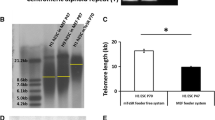Abstract
The effects of selenium, zinc, iron, chromium, and lead on telomere lengths of human cells have not been investigated. This article adopted flow cytometry and fluorescence in situ hybridization to investigate the impact of different elements on cellular apoptosis and telomere lengths of human hepatocytes L-02 and hepatoma cells SMMC-7721. Results showed that these trace elements under the following dosages did not have remarkable effect on cellular apoptosis. However, sodium selenite at doses of 0.5 and 2.5 μmol/L significantly extended the telomere length of hepatocytes L-02; 0.5 μmol/L lead acetate remarkably shortened the telomere length of L-02 cells; 80 μmol/L zinc sulfate, 20 μmol/L ferric chloride, and 200 μmol/L chromic chloride only had slight impact on the telomere length, respectively. Regarding hepatoma cells SMMC-7721, sodium seleite at 0.5 and 2.5 μmol/L had little impact on the telomere length; 80 μmol/L zinc sulfate significantly accelerated the loss of telomere length, whereas 20 μmol/L ferric chloride, 200 μmol/L chromic chloride, and 0.5 μmol/L lead acetate remarkably extended the telomere lengths, respectively. The results revealed differential effects of each trace element on the life-span of human hepatocytes and hepatoma cell lines, which suggested further research on somatic hepatocytes and hepatoma in vivo.
Similar content being viewed by others
References
K. Wang, H. B. Xu, R. H. Tang, et al., Trace Elements in Life Science, Chinese Computation Press, Beijing (1992).
I. E. Dreosti, Zinc and the gene, Mutat. Res. 475, 161–167 (2001).
D. L. Hatfield, Selenium, Its Molecular Biology and Role in Human Health, Kluwer Academic, Boston (2001).
V. Abalea, J. Cillard, M. P. Dubos, et al., Iron-induced oxidative DNA damage and its repair in primary rat hepatocyte culture, Carcinogenesis 19, 1053–1059 (1998).
J. Singh and E. T. Snow, Chromium(III) decreases the fidelity of human DNA polymerase beta, Biochemistry (Wash.) 37, 9371–9378 (1998).
J. Blasiak and J. Kowalik, A comparison of the in vitro genotoxicity of tri- and hexavalent chromium, Mutat. Res. Genet. Toxicol. Environ. Mutag. 1, 135–145 (2000).
K. Steenland and P. Boffetta, Lead and cancer in humans: Where are we now?, Am. J. Ind. Med. 38, 295–299 (2000).
R. K. Boyzis, J. M. Buckingham, L. S. Cram, et al., A highly conserved repetitive DNA sequence (TTAGGG)n present at the telomeres of human chromosomes, Proc. Natl. Acad. Sci. USA 85, 6622–6626 (1988).
J. P. Hanish, J. L. Yanowitz, and T. De Lange, Stringent sequence requirements for the formation of human telomeres, Proc. Natl. Acad. Sci. USA 91, 8861–8865 (1994).
E. H. Blackburn, Structure and function of telomeres, Nature 350, 569–578 (1991).
P. A. Kruk, N. J. Rampino, and V. A. Bohr, DNA damage and repair in telomeres: relation to aging, Proc. Natl. Acad. Sci. USA 92, 256–262 (1995).
C. B. Harley, A. B. Futcher, and C. W. Greider, Telomeres shorten during aging of human fibroblasts, Nature 345, 458–460 (1990).
E. Raymond, D. Sun, S. F. Chen, et al., Agents that target telomerase and telomeres, Curr. Opin. Biotechnol. 7, 583–591 (1996).
J. W. Shay, H. Werbin, and W. E. Wright, Telomeres and telomerase in human leukemias, Leukemia 10, 1255–1261 (1996).
C. M. Counter, A. A. Avilion, C. E. LeFeuere, et al., Telomere shortening associated with chromosome instability is arrested in immortal cells which express telomerase activity, EMBO J. 11, 1921–1929 (1992).
T. von Zglinicki, Oxidative stress shortens telomeres, Trends Biochem. Sci. 27, 339–344 (2002).
T. von Zglinicki, Role of oxidative stress in telomere length regulation and replicative senescence, Ann. NY Acad. Sci. 908, 99–110 (2000).
F. M. Batliwalla, R. N. Damle, C. Metz, et al., Simultaneous flow cytometric analysis of cell surface markers and telomere length: analysis of human tonsilar B cells, J. Immunol. Methods 247, 103–109 (2001).
N. Rufer, W. Dragowska, G. Thornbury, et al., Telomere length dynamics in human lymphocyte subpopulations measured by flow cytometry, Nature Biotechnol. 16, 743–747 (1998).
F. M. Batliwalla, N. Rufer, P. M. Lansdorp, et al., Oligoclonal expansions in the CD8+ CD28− T cells largely explain the shorter telomeres detected in this subset: analysis by flow FISH, Hum. Immunol. 61, 951–958 (2000).
T. L. Ware, H. Wang, and E. H. Blackburn, Three telomerases with completely non-telomeric template replacements are catalytically active, EMBO J., 19, 3119–3131 (2000).
C. Meplan and P. Hainaut, Molecular alchemy of the tumor suppressor protein p53: metals and cell growth control, J. Trace Elements Exp. Med. 4, 337–346 (1999).
R. L. Nelson, Iron and colorectal cancer risk: human studies, Nutr. Rev. 59, 140–148 (2001).
X. F. Yuan and C. C. Tang, The accumulation effect of lead on DNA damage in mice blood cells of three generations and the protection of selenium, J. Environ. Sci. Health A: Toxic/Hazard. Subst. Environ. Eng. A36, 501–508 (2001).
Author information
Authors and Affiliations
Rights and permissions
About this article
Cite this article
Liu, Q., Wang, H., Hu, D. et al. Effects of trace elements on the telomere lengths of hepatocytes L-02 and hepatoma cells SMMC-7721. Biol Trace Elem Res 100, 215–227 (2004). https://doi.org/10.1385/BTER:100:3:215
Received:
Revised:
Accepted:
Issue Date:
DOI: https://doi.org/10.1385/BTER:100:3:215




